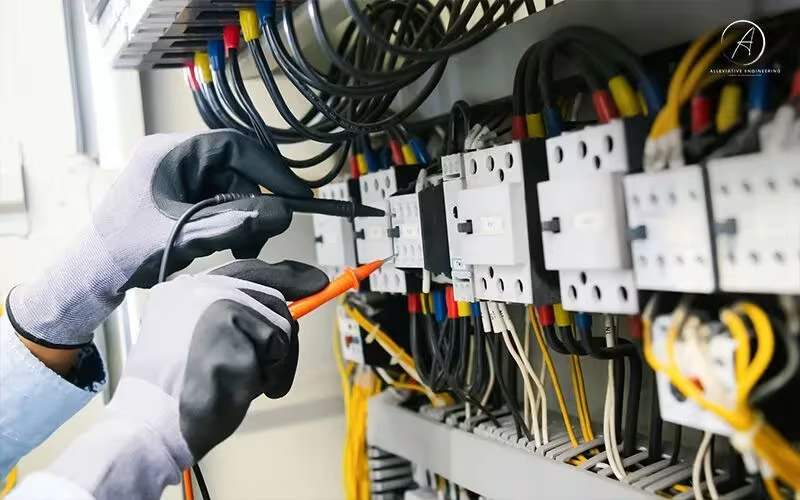Okay, let’s be honest. Ever had one of those days where everything’s humming along perfectly on the shop floor, orders are flying out, and then… bam? Silence. A critical machine just quits. After the frantic scramble, the tech holds up a sad-looking wire – frayed, burnt, or just plain broken. Premature wiring failure. It’s the ultimate productivity buzzkill, right? Costly downtime, potential safety headaches, and that sinking feeling of "not again."
Thing is, it’s rarely just "bad luck" or a "cheap wire." Industrial environments? They’re basically boot camps for electrical components. They push things to the absolute limit. Understanding why wires throw in the towel early is your secret weapon to keeping things running smoothly and avoiding those unplanned coffee breaks (that nobody actually wants). Let’s break down the usual suspects and, more importantly, how you can fight back.
The Environment: Not Exactly Wiring’s Best Friend
Man, industrial settings can be brutal. Think about it:
- Temperature Tantrums: Ever left a rubber band out in the sun? Gets brittle, snaps easy. Same thing happens to wire insulation with too much heat – it cracks. On the flip side, bitter cold makes insulation stiff as a board. Try bending a frozen garden hose – not pretty. That stiffness leads to cracks when things vibrate or move. And those constant temperature swings? They make wires and connections expand and contract like crazy, slowly loosening things up over time. It died by a thousand thermal cycles.
- Dust Bunnies & Moisture Monsters: Water sneaking into connections is like inviting rust to a party. Corrosion builds up on conductors and terminals, making electricity struggle to flow (hello, heat and shorts!). Dust, especially the nasty conductive or gritty kind you find grinding metal or sawing wood, gets everywhere. It can cause little sparks (arcing), short circuits, and just sandpaper away insulation like nobody’s business. Now, in places where keeping stuff out is absolutely critical – like around sensitive gear or harsh processes – that’s where something like a molded cable assembly really shines. Picture this: instead of a bunch of separate parts potentially letting gunk in, it’s all one smooth, sealed unit. Like a perfectly fitted raincoat for the connection points, keeping moisture, dust, and grime locked out. Makes a huge difference in lifespan when things get messy.
Getting Beat Up: The Physical Grind
Wires aren’t meant to be wrestlers or acrobats, but man, do they get put through the wringer!
- Shake, Rattle, and Roll: That constant vibration from big presses, stampers, or rumbling conveyors? It’s relentless. It shakes connections loose, makes conductors tired (metal fatigue is real!), and rubs insulation raw against sharp edges or other wires. Imagine tiny sandpapering happening 24/7.
- Bend, Pull, Snag, Crush: Yanking a wire too hard during install? Kinking it around a sharp corner? Getting caught by a forklift or squashed under a pallet? These are instant killers or slow killers. Bending a cable tighter than it’s designed for (its "bend radius") damages the insides over time. And abrasion? That slow rub-rub-rub against a machine frame or conduit? It’s like water dripping on stone – eventually, it wears through the tough outer jacket and then the insulation underneath. Using cable carriers (like those flexible drag chains) and beefy strain relief clamps isn’t just fancy stuff; it’s essential armor.
Chemical Warfare on the Shop Floor
Oils, solvents, degreasers, acids, coolants… our industrial world runs on some pretty potent stuff. Unfortunately, standard wiring often doesn’t stand a chance.
- Material Meltdown: Some plastics used in insulation just don’t play nice with certain chemicals. They might swell up like a sponge, get weirdly soft, turn brittle as glass, or even start dissolving. Once the insulation is compromised, it’s game over – shorts, weird currents, failure. Think of cheap plastic left in gasoline.
- Corrosion Conundrum: It’s not just water that causes rust. Those chemical fumes and splashes attack metal conductors and terminals too. More resistance means more heat (scary!), leading to flickering connections or total meltdowns. Honestly, picking wire specifically designed to laugh off the chemicals your process uses? Non-negotiable. Check the specs – look for "oil-resistant," "chemical-resistant." It’s a lesson we can borrow from seriously demanding places, like hospitals. You know those cables hooked up to vital monitors or machines? That medical cable assembly isn’t just precise; it’s built to survive repeated chemical baths during sterilization – autoclaves, strong disinfectants, the works. It shows just how tough wiring can be when matched perfectly to its chemical battlefield, even on the factory floor.
It's Electric (And Not Always in a Good Way)
Sometimes the juice itself, or how it's handled, is the problem.
- Overworked and Overheated: Pushing more current through a wire than it’s rated for is like revving a small engine non-stop. It generates crazy heat, cooking the insulation and potentially melting the metal inside. Sure, fuses blow to stop disasters, but running constantly near the max limit? That still shortens a wire’s life dramatically. It’s just stressful!
- Spikes and Surges: Lightning strikes nearby, or even just switching a massive motor on or off, can send nasty voltage spikes zipping down the line. These can punch right through insulation, frying wires and whatever’s plugged in. Think of it as an electrical sledgehammer.
- Loosey-Goosey Connections: A terminal that’s not quite tight, a crimp that wasn’t perfect, a bit of corrosion – these create "hot spots." High resistance means heat, which makes the connection worse, which creates more heat. It’s a vicious cycle that ends badly. Good surge protection and taking real pride in making clean, tight connections are lifesavers.
Oops! When Human Hands (or Oversight) Cause Trouble
Even the best wire won’t last if it’s installed wrong or ignored.
- Installation Blunders: Pulling wires like you’re starting a lawnmower (snapping conductors inside), bending them into pretzels, using the wrong type for the job (like standard wire near an oven), forgetting strain relief, or running them right through a chemical spray zone or across a sharp edge – all guaranteed shortcuts to failure. Also, jamming power cables right next to signal cables? That’s asking for weird electronic gremlins (EMI) causing machines to act possessed.
- Out of Sight, Out of Mind: The biggest mistake? Not looking! If you never check wiring for signs of wear – little nicks, cracks, corrosion, loose ends, or telltale brown burn marks – small problems become catastrophic failures. Dust bunnies insulating wires can trap heat too. Being proactive, having a regular "wire walk" inspection routine? It’s way cheaper than a surprise shutdown. This is super critical for complex, constantly moving stuff. Take those intricate arms on robots. The whole point of a specialized robotic wire harness assembly is precision – wires routed perfectly, using conductors that love to flex, with strain relief built for millions of bends. But guess what? Even these marvels need a watchful eye. You gotta check regularly to make sure all that graceful movement isn’t secretly wearing a weak spot somewhere over thousands upon thousands of cycles. Complacency is the enemy.
The Bottom Line: Wiring is an Investment, Not Just a Cost
Look, wires failing early in factories is a headache with a ton of causes – Mother Nature’s wrath, physical beatings, chemical attacks, electrical stress, and yeah, sometimes we humans mess up. But here’s the good news: it’s almost never unavoidable.
Getting smart about why wires fail gives you the power to stop it. Choosing wisely, installing carefully, adding protection, and staying vigilant with maintenance – this combo is your recipe for wiring that lasts. Think of your wiring as the nervous system of your operation. Investing a little more time and care upfront saves a fortune in downtime, avoids safety scares, and keeps everything humming along profitably. Reliable wiring isn't glamorous, but it’s the bedrock of a smooth-running plant.



